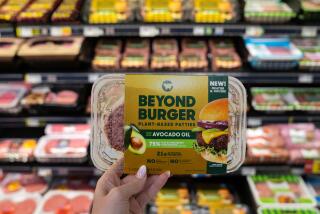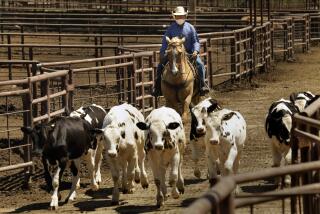Where’s the Fat? : Marketing: Industry experts say consumers won’t sacrifice tenderness and flavor for healthier beef. They’re offering SmartMeat as the answer.
- Share via
The beef industry’s stampede to introduce low-fat products gained further momentum with the recent debut of SmartMeat, the result of four years of research and millions of dollars in product development.
The trademarked process, engineered by Minneapolis-based GFI America, is possibly the most technologically advanced method to enter the lucrative lean-beef sweepstakes.
The target audience is the growing number of health-conscious consumers influenced by volumes of medical research indicating that diets low in fat can reduce the risk of heart disease and cancer.
“I don’t believe that the customer will give up both tenderness and good taste to eat healthy beef,” says Robert Goldberger, president of GFI. “People want the decadence (of fat) but don’t want to pay the penalty. I think we have created that in SmartMeat.”
There are several qualities that distinguish SmartMeat from previous defatting efforts. The firm uses only meat from grass-fed cattle that have not been further fattened in feedlots. This beef, tough to unchewable, is skinned, or removed of all external fat. Then it is mechanically tenderized, during which time a solution of margarine, water, hydrolyzed vegetable (soy) protein, salt and dextrose is added to the cuts, roasts or ground product. The margarine mixture is present in SmartMeat up to a 15% level.
Goldberger declines to state how the tenderization process actually takes place other than to say that the technique is called “vacu-marbling.” Others familiar with his product, however, speculate that the margarine-water mixture is mechanically injected into the beef and stabilized.
“Our machine puts the marbling into the meat and (makes sure) it isn’t going to come out,” Goldberger says.
In any event, SmartMeat, among the leanest processed beef products available, is sold in tenderloin, strip, rib eye and other cuts. Each one-ounce portion contains about 3.8% total fat versus about 4.9% total fat in a similar cut of USDA Select beef, or an overall 28% reduction. (USDA Select, a 100% beef product, is recommended for its low-fat levels.) Reductions are also achieved in SmartMeat’s cholesterol and calorie levels versus other all-beef cuts.
However, Goldberger says that his tenderized product has a significantly enhanced flavor that makes it comparable, at least in taste, to the more desirable USDA Choice grade, which contains total fat levels of about 21.7%. SmartMeat also compares favorably, in terms of fat, cholesterol and calorie levels, with chicken cooked with the skin on.
In fact, SmartMeat does visually resemble USDA Choice steaks because it contains a fairly high degree of marbling. In a 100% beef steak, the marbling would be flecks of fat in the red portion of the meat, used by government inspectors as an indicator of flavor and tenderness. In SmartMeat, the marbling is more likely to be evidence of the margarine mixture than of fat.
“The raw beef that we use is tough and tasteless but also low in cholesterol and low in saturated fat,” Goldberger says. “Now we found a way to eliminate the fact that it was tough, make it as soft (tender) as we want and then give it flavor.”
SmartMeat is now available in seven Minneapolis area supermarkets, and Goldberger says that the firm is on the verge of national distribution. The products should be available in California by November.
SmartMeat comes on the heels of the much-heralded McLean Deluxe from McDonalds, a patty containing 9% fat that owes its nutritional profile to the inclusion of carrageenan, a seaweed-based ingredient. Others, such as Dakota Lean Meats, have also introduced super-lean products.
Dakota, however, achieves its low-fat products by selective breeding of cattle. Although Dakota’s New York Strip steak contains only 0.45 grams of fat per one ounce portion, or 40% less than a similar cut of SmartMeat, the difficulties in breeding cattle to these specifications have limited the availability of Dakota Lean. (The brand is available at Trader Joe’s Markets in Southern California and by mail order at (800) 727-5326.)
There is no such limitation on SmartMeat production. In fact, Goldberger says that the beef used for his trademarked steak and roasts, which would be salable otherwise only as a ground product, is widely available.
There was a time 10 to 15 years ago when a product such as SmartMeat would have been considered “heretical” because it was not 100% beef, says Rosemary Mucklow, executive director of the Western States Meat Assn., an Oakland-based trade group.
“We’ve crossed the (psychological) barrier for people (in the business) to make these kinds of changes,” Mucklow says. “In the minds of consumers today the question is how to make a lean product and get rid of that nasty old fat . . . There is no one solution to providing lean meat for everyone.”
The emergence of products such as SmartMeat, McLean Deluxe and Dakota Lean prompted the National Cattlemen’s Assn. to pass a resolution at a recent annual meeting endorsing these products.
According to Roger Berglund, a cattlemen’s spokesman, the resolution read: “We support the development of new technologies and ingredients that enhance the beef industry’s opportunity to market low fat/low cholesterol products.”
Berglund conceded that the Denver-based group’s stand is a change from previous years when the association members were against adding “anything to (fresh) beef.”
Support was also expressed by a representative of the American Meat Institute, which represents packers and processors.
“We’re very supportive of research and development designed to produce lower-fat meat product. And fat-reduced foods appeal to certain market segments,” says Sara Clarke, institute vice president.
One industry observer predicts that other beef products will emerge that have even less fat than SmartMeat.
“I think it is possible to accomplish a good flavored product without any fat,” says Glenn Schmidt, an animal sciences professor at Colorado State University in Fort Collins. “This concept of taking lean meat and enhancing its flavor and tenderness is a good idea. Whether we need to add any fat back to the beef at all is open to question.”
Schmidt said that the meat industry must produce low-fat products that are tender, taste good and contain the proper nutritional labeling. And, he warned, the meat must not “have any (suspect) ingredients that drive the consumer away.”
Even so, Schmidt is not convinced that the current products will satisfy the public.
“These low-fat meat products were available in the past but the consumer wasn’t ready. Now, we’ll see if the consumer is ready,” he says. “People may try these things once but the real test will be whether they make any return purchases.”
Goldberger, of SmartMeat, is optimistic.
“All we are trying to do is this: develop what the consumer wants,” he says. “The beef industry has not done the proper marketing to find out what the customer wants. The customer wants lean beef.”
Clarke, of the American Meat Institute, says that the reduced-fat movement will next be extended to pork. She says a low-fat pork sausage will be introduced by a North Carolina-based firm some time this month.
More to Read
Eat your way across L.A.
Get our weekly Tasting Notes newsletter for reviews, news and more.
You may occasionally receive promotional content from the Los Angeles Times.










